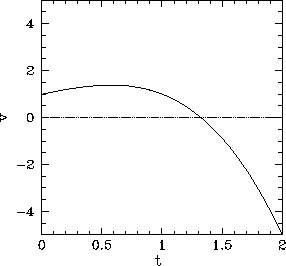| (12) |
Velocity is the rate of change of displacement with time.This definition implies that
How should we choose the
time interval
![]() appearing in Eq. (12)?
Obviously, in the simple case in which the
body is moving with constant velocity, we can make
appearing in Eq. (12)?
Obviously, in the simple case in which the
body is moving with constant velocity, we can make
![]() as
large or small as we like, and it will not affect the value of
as
large or small as we like, and it will not affect the value of ![]() . Suppose, however,
that
. Suppose, however,
that ![]() is constantly changing in time, as is generally the case.
In this situation,
is constantly changing in time, as is generally the case.
In this situation,
![]() must be kept sufficiently small that the body's velocity
does not change appreciably between times
must be kept sufficiently small that the body's velocity
does not change appreciably between times ![]() and
and
![]() . If
. If
![]() is made too large then formula (12) becomes invalid.
is made too large then formula (12) becomes invalid.
Suppose that we require a general expression for instantaneous velocity which
is valid irrespective of how rapidly or slowly the body's velocity changes in time.
We can achieve this goal by taking the limit of Eq. (12) as
![]() approaches
zero. This ensures that no matter how rapidly
approaches
zero. This ensures that no matter how rapidly ![]() varies with time, the velocity
of the body is always approximately constant in the interval
varies with time, the velocity
of the body is always approximately constant in the interval ![]() to
to
![]() .
Thus,
.
Thus,
| (14) |
 |
The terms velocity and speed are often confused with one another.
A velocity can be either positive or negative, depending on the
direction of motion. The conventional definition of speed is that
it is the magnitude of velocity (i.e., it is ![]() with the sign stripped
off). It follows that a body can never possess a negative speed.
with the sign stripped
off). It follows that a body can never possess a negative speed.